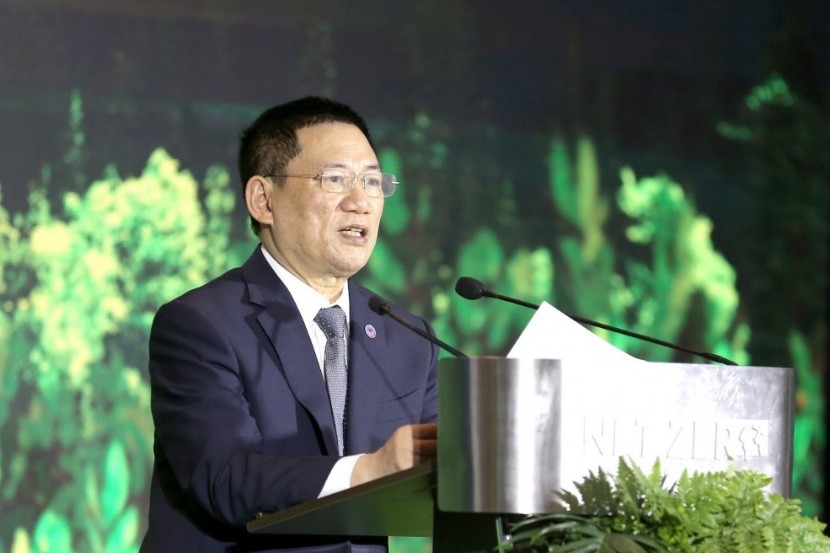On June 27th in Hanoi, Vietnam Television held a seminar titled "Net Zero - Green Shift: Opportunities for Leaders," with the goal of contributing to the process of "green transformation," bringing Vietnam's economy towards "green growth" sustainability, implementing the commitment to Net-Zero greenhouse gas emissions, and integrating with the global development trend.
 |
| Minister Ho Duc Phoc stated that over the past time, many fiscal policies have been issued to concretize guidelines on green economic development. Photo: LV |
More tax incentives for green growth
Finance Minister Ho Duc Phoc stressed at the seminar that climate change and environmental pollution are global issues that could jeopardize food security, water security, and the long-term development of many countries and communities. Vietnam is one of the countries that bears the brunt of the negative consequences of climate change, which is becoming increasingly complicated in terms of both degree and frequency.
| To date, approximately 140 countries, accounting for nearly 90% of global emissions, including major emitters such as the United States, China, and India, have committed to or are on their way to Net-Zero emissions. Each country sets its own timeline for meeting this target, largely by 2050, with a handful of exceptions by 2035 and by 2070 at the latest. |
As a result, Vietnam must make significant efforts to both develop a sustainable economy and adapt to and mitigate the effects of climate change, greenhouse gas emissions, fossil energy, and environmental pollution. The Prime Minister of Vietnam made a commitment to achieve Net-Zero emissions by 2050 at the COP 26 (UN Climate Change Conference of the Parties) in 2021, together with the international community, demonstrating Vietnam's determination to implement green transformation and sustainable development goals.
Minister Ho Duc Phoc demonstrated that financial policies have been issued in recent years to concretize the Party and State's guidelines and orientations on green economic development, contributing to the creation of conditions to mobilize and attract investment resources toward green growth.
Concerning the tax policy system, the Ministry of Finance (MoF) has advised the Government to promulgate the provisions of the law aimed at environmental protection, as expressed through two following policy groups. First, policies aim to limit environmental pollution, such as environmental protection taxes, natural resource taxes, and excise taxes on environmentally hazardous goods. Second, policies are to support and encourage environmental protection activities, as well as to reduce pollution and the effects of climate change.
In particular, in terms of corporate income tax (CIT), the preferential CIT rate stands at 10% for 15 years, exempts tax for no more than four years, and halves payable CIT for no more than nine subsequent years for corporate income from new environmental investment projects.
Regarding value-added tax (VAT), it is stipulated that the transfer of emission rights (carbon credits) is not required to declare and pay VAT; goods and services that contribute to greening the economy are exempt from VAT. For instance, services related to flower gardens, parks, ornamental plants, and passenger transportation by tram are exempt from VAT.
Concerning excise tax, tax incentives are given to products such as biogasoline, and environmentally friendly cars.
The budget for environmental protection is annually increasing
The Minister of Finance stated at the seminar that, in the context of existing difficulties in the State budget, State budget expenditures have prioritized the annual environmental protection career under regulations, the following year is higher than the previous year in terms of absolute number, reaching approximately 1.35% of aggerate state budget expenditure within one year. Therefore, it has created resources for environmental protection, prevention, and response to national environmental incidents.
| 3 components of the green financial market in Vietnam Up to now, the green financial market in Vietnam has shaped its foundation and development with three components: the green credit market; the green stock market, and the green bond market. |
According to MoF statistics, State budget expenditure for environmental protection has exceeded 21 trillion VND per year over the last five years.
Concerning investment expenditure, the budget for green growth has been integrated into sectoral, sectoral, local investment priorities, and national target programs. The estimated investment expenditure for environmental protection in the period 2021-2025 is 23.5 trillion VND.
Regarding ODA, Vietnam signed an agreement in 2022 that shall mobilize 15.5 billion USD in public and private capital for Vietnam's green transfer, with ODA accounting for approximately 8.4 billion USD within 3 or 4 years.
Minister Ho Duc Phoc stated that, in addition to public resources, Vietnam has recently mobilized resources from the private sector and international organizations through the formation and development of green financial markets. From 2019 to 2023, Vietnam issued green bonds worth 1.157 billion USD.
Moreover, the green stock market has begun to develop. The VNSI (Sustainable Development Index) was launched in 2017 to identify sustainable development standards for listed companies and to assist investors in identifying "green" businesses to invest in.
Furthermore, the MoF has developed and completed regulations related to the function of sustainable finance, improved corporate governance standards, and disclosed information connected with environmental, social, and corporate governance (ESG) criteria.
Mobilize private resources and international organizations for green transformation
"Green transformation and emission reduction to implement the Net Zero commitment is a long way with plenty of difficulties and challenges; one of the biggest challenges is the issue of resources. However, the public sector is only able to provide about one-third of the resources needed; while the green financial market is still in its early stages of development, the resources mobilized through the green financial market are very small in comparison to the demand,” emphasized Minister Ho Duc Phoc.
According to World Bank estimates (2022), Vietnam may need to invest an additional 368 billion USD until 2040, equivalent to 6.8% of GDP per year, to pursue a development scheme that combines tolerance and “Net-Zero”emissions. The journey to reduce carbon emissions to meet international commitments, in particular, accounts for approximately 30% of aggerate resource demand.
Minister Ho Duc Phoc stated that the MoF is currently focusing on implementing tax system reform, public debt management, and restructuring the State budget to mobilize resources reasonably for the State budget to carry out the task of reducing greenhouse gas emissions, promoting clean energy, renewable energy, greening production, greening lifestyle, boosting consumption, and sustainability. Simultaneously, the Ministry improves fiscal space by creating favorable conditions for harmoniously mobilizing, allocating, and utilizing financial resources, resolving economic, social, and environmental development issues, and ensuring national defense and social security.
At the same time, to address the shortage of resources for green growth and climate change response, Vietnam needs to strengthen cooperation and support from the international community in addition to promoting internal resources. As a result, the MoF will actively coordinate with relevant ministries and agencies in researching solutions to mobilize private resources and international organizations, in addition to prioritizing public resources. Developing green financial markets and carbon markets, in particular, should be a top priority./.




















































